Instructions for installing .NET Framework 3.5 on Windows 10
Windows 10 comes pre-installed with .NET framework 4.8. However, many applications developed from Windows Vista and Windows 7 require .NET Framework v3.5 version to run. Applications will not run unless you install the correct version of the .NET Framework that the application requires.
Note : You must log in with admin rights to install .NET Framework 3.5.
If you need to repair .NET Framework 3.5, you can uninstall and reinstall using the options below.
What is .NET Framework?
Microsoft .NET Framework is an open source software development framework created by Microsoft. The first version was released in 2002. It included both Command Language Runtime and Framework Class Library.
The .NET Framework was created to make it easier to design web applications and software across multiple languages. Developers can create applications for Windows, Microsoft Azure, Windows Server, and XML Web services on a single platform.
Install .NET Framework 3.5 as needed
This option requires an Internet connection to install the .NET Framework 3.5.
1. You may see the following configuration dialog if you try to run an application that requires the .NET Framework 3.5. Click Install this feature .

2. If prompted by UAC, click Yes.
3. Windows Features will now search, download, and install the necessary files for the .NET Framework 3.5 online from Windows Update.
4. Click Close when completed and installation is successful.
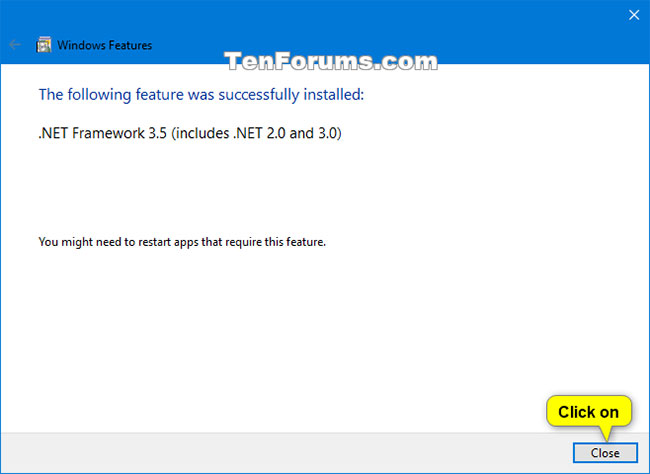
Install .NET Framework 3.5 in Windows Features
This option requires an Internet connection to install the .NET Framework 3.5.
1. Open Control Panel (icon view) and click the Programs and Features icon .
2. Click the Turn Windows features on or off link on the left.
This will open the file C:WindowsSystem32OptionalFeatures.exe.
3. If prompted by UAC, click Yes.
4. Select (black square) .NET Framework 3.5 (includes .NET 2.0 and 3.0) and click OK.
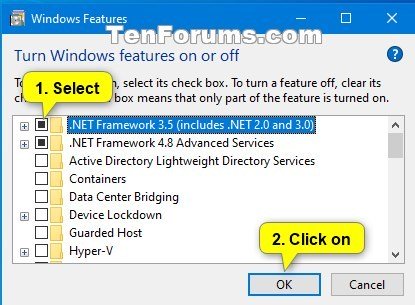
5. Click Let Windows Update download the files for you.
6. Windows Features will now download and apply (install) the necessary files for .NET Framework 3.5 online from Windows Update.
7. Click Close when done.
Install .NET Framework 3.5 by downloading it
This option requires an Internet connection to install the .NET Framework 3.5.
1. Go to Microsoft's Download .NET Framework 3.5 SP1 website and click the Download .NET Framework 3.5 SP1 Runtime button on the website.
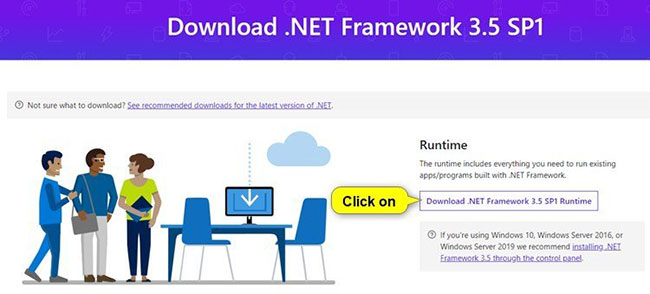
2. Save the dotnetfx35.exe file to the desktop and run it.
3. If prompted by UAC, click Yes.
4. Click Download and install this feature .
5. Windows Features will now search, download, and install the necessary files for the .NET Framework 3.5 online from Windows Update.
6. Click Close when completed and installation is successful.
7. Now, you can delete the dotnetfx35.exe file if you want.
Install .NET Framework 3.5 in Command Prompt
This option requires an Internet connection to install the .NET Framework 3.5.
1. Open Command Prompt with admin rights.
2. Copy and paste the command below into Command Prompt, then press Enter.
Dism /online /Enable-Feature /FeatureName:"NetFx3"3. Once installation is complete, you can close Command Prompt if you want.
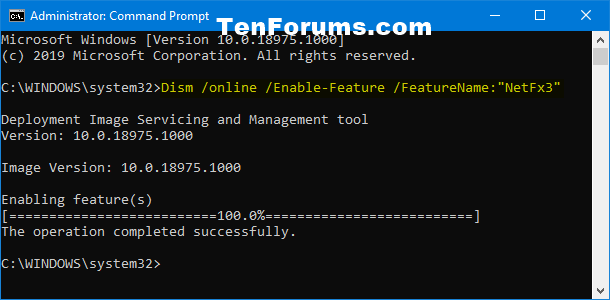
Install .NET Framework 3.5 in PowerShell
This option requires an Internet connection to install the .NET Framework 3.5.
1. Open PowerShell with admin rights.
2. Copy and paste the command below into PowerShell, then press Enter.
Enable-WindowsOptionalFeature -Online -FeatureName "NetFx3"3. Once installation is complete, you can close PowerShell if you want.

Install .NET Framework 3.5 offline
This option does not use an Internet connection to install the .NET Framework 3.5. This can be useful if you can't install .NET Framework 3.5 using any of the other options above.
1. Do one of the following actions depending on what you want to use:
If you are not using media with the same build of Windows 10 as what is currently installed, you will get a source file not found error and .NET Framework 3.5 will not install.
A) Connect a Windows 10 installation USB of the same build as what is currently installed.
Or:
B) Mount a Windows 10 ISO of the same build as what is currently installed.
2. Open This PC in File Explorer ( Win + E ) and note down the drive letter (e.g. "G") of this USB or mounted ISO.
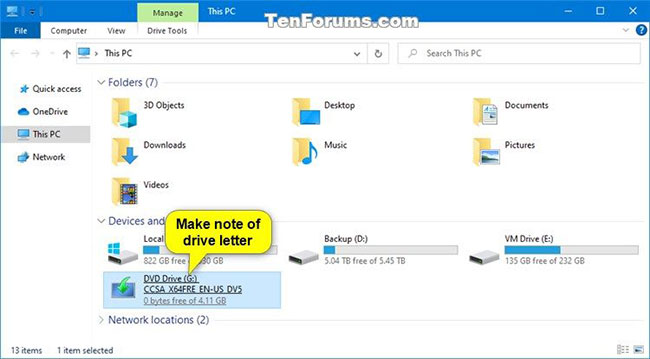
3. Open Command Prompt with admin rights.
4. Enter the command below into Command Prompt and press Enter.
Dism /online /enable-feature /featurename:NetFX3 /Source::sourcessxs /LimitAccessReplace in the command above with the actual drive letter (e.g. "G") from step 2 above for the mounted USB or ISO source.
For example:
Dism /online /enable-feature /featurename:NetFX3 /Source:G:sourcessxs /LimitAccess5. After finishing the installation, you can close Command Prompt if you want.
Available .NET Framework versions
Although this article focuses on .NET Framework version 3.5, that is not the only version available. As of August 2021, the latest version is actually .NET Framework 4.8.
The current list of old versions includes:
- .NET Framework 2.0
- .NET Framework 3.0
- .NET Framework 3.5 (installing 3.5 also installs 2.0 and 3.0)
- .NET Framework 4.0
- .NET Framework 4.5
- .NET Framework 4.5.1
- .NET Framework 4.5.2
- .NET Framework 4.6
- .NET Framework 4.6.2
- .NET Framework 4.7
- .NET Framework 4.7.1
- .NET Framework 4.7.2
Fix installation problems
Although you usually won't encounter any problems when installing the .NET Framework, sometimes problems appear. Some of the most common problems include:
Compatibility error - If you receive a message that the .NET Framework is not compatible with your operating system, then the version you are trying to install is not compatible and will not work. If you know for sure it's supported, install the latest Windows update. This error usually occurs when trying to install a newer version on an old PC.
Invalid Windows installation - If you are not running a licensed copy of Windows, the .NET Framework may not install at all. Registering your copy or installing a valid copy is the only solution.
Problems with Windows Update - If you get errors about a specific KB number or require additional updates, install all the latest Windows updates before continuing.
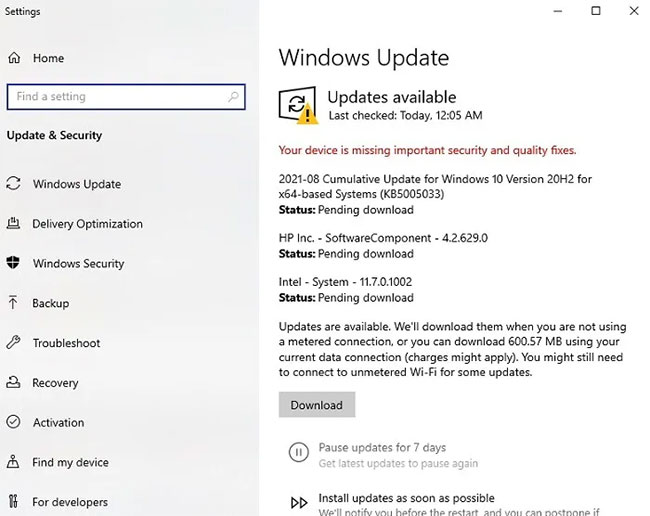
Error downloads - If you get any errors about corrupted installations, check the Add or Remove Programs section to see if anything is installed. Uninstall them if possible. Then, manually download the version you need and install it that way.
Microsoft offers more troubleshooting options for more advanced errors. Refer to:
https://docs.microsoft.com/en-us/dotnet/framework/install/troubleshoot-blocked-installations-and-uninstallationsFrequently asked questions when installing the .NET Framework
1. Is it possible to install multiple versions of the .NET Framework?
Yes, you can install multiple versions of the .NET Framework. Different applications require different versions and can exist peacefully on the same PC. But be sure to only install the .NET Framework versions you really need.
2. How long are .NET Framework versions supported?
.NET Framework 3.5 SP1 is supported through October 10, 2028. This is ideal for applications that require versions 2.0, 3.0, and/or 3.5. They are supported for a long time because it is the most popular and stable older version.
Versions 4.0 to 4.5.1 are no longer supported. Versions 4.5.2 to 4.6.1 wukk will end support on April 26, 2022.
Versions 4.6.2 and later do not currently have an end of support date listed.
3. How can compatibility be checked?
If you're not sure whether your PC supports the specific version of the .NET Framework you want to install, you can easily check. Microsoft has a list of dependencies and system requirements for every version of the .NET Framework. For detailed instructions, please refer to the article: How to check the .NET Framework version on your computer.
You can now run programs that require older versions of the .NET Framework on your PC. Please share which of these Microsoft NET Framework installation methods is right for you in the comments section below!
Wish you success!
You should read it
- What is the Microsoft .NET Framework, and why is it installed on the PC?
- Fix the error of not installing the .NET Framework 3.5 on Windows
- How to install Microsoft NET Framework 4.5 full for Windows 7, 8 with Windows Update
- How to enable .NET FrameWork on Windows 10?
- Fix error 0x800F081F when installing .Net Framework 3.5
- Is Framework Laptop the modular laptop you've been waiting for?
- Top 5 popular CSS Framework that you should keep in mind
- TOP 10 best Web Framework, most worth using
May be interested
- How to fix the error 'The .NET Framework is not supported on this operating system'
 when installing a program or a specific version of the .net framework on windows 10, some users get the error 'the .net framework is not supported on this operating system'.
when installing a program or a specific version of the .net framework on windows 10, some users get the error 'the .net framework is not supported on this operating system'. - How to fix error 0X800F080C when installing NET Framework on Windows 10
 error 0x800f080c often appears when installing additional net framework for other software on windows 10 computers.
error 0x800f080c often appears when installing additional net framework for other software on windows 10 computers. - What is the Microsoft .NET Framework, and why is it installed on the PC?
 if you are interested in knowing everything, let's discover what .net is and why so many applications need it in the following article.
if you are interested in knowing everything, let's discover what .net is and why so many applications need it in the following article. - .NET Framework 3.0 (WinFX)
 at the end of may 2006, microsoft unveiled the beta version of windows vista with a number of models and tools for developing windows applications such as .net framework 3.0 (formerly known as winfx), office 2007 ... in there are tools related to .net framework 3.0
at the end of may 2006, microsoft unveiled the beta version of windows vista with a number of models and tools for developing windows applications such as .net framework 3.0 (formerly known as winfx), office 2007 ... in there are tools related to .net framework 3.0 - How to install and activate the .NET Framework 3.5 on Windows 10
 on windows 10, by default, the latest .net framework 4.5 will be installed, but some older applications still require you to install .net framework 3.5 to run it. if you do not know how to install .net framwork 3.5 on windows 10, let's find out how to install it in the following tutorial!
on windows 10, by default, the latest .net framework 4.5 will be installed, but some older applications still require you to install .net framework 3.5 to run it. if you do not know how to install .net framwork 3.5 on windows 10, let's find out how to install it in the following tutorial! - Instructions for installing screensavers on Windows
 screen savers that many users are familiar with are screensavers, but what is a screensaver? how to install screensavers on a computer? learn about screensavers and how to install screensavers on windows operating systems through the following article.
screen savers that many users are familiar with are screensavers, but what is a screensaver? how to install screensavers on a computer? learn about screensavers and how to install screensavers on windows operating systems through the following article. - How to check .NET Framework version on Windows 10
 some software requires you to install the appropriate version of the .net framework to run, here are the two simplest and most common ways to check the .net framework version.
some software requires you to install the appropriate version of the .net framework to run, here are the two simplest and most common ways to check the .net framework version. - Download Net Framework 4.5 full Online - Offline
 microsoft .net framework 4.5.2 full is a programming platform that supports the use and installation of software on personal computers. net framework 4.5.2 is a new upgraded version with many features that support many software on the system, helping your operating system operate more stably and securely.
microsoft .net framework 4.5.2 full is a programming platform that supports the use and installation of software on personal computers. net framework 4.5.2 is a new upgraded version with many features that support many software on the system, helping your operating system operate more stably and securely. - Is Framework Laptop the modular laptop you've been waiting for?
 framework laptop is a hot new modular laptop that has been praised by reviewers and tech enthusiasts alike. but why is everyone so excited about the release of the laptop framework? and what makes it different from other modular laptops that come before it?
framework laptop is a hot new modular laptop that has been praised by reviewers and tech enthusiasts alike. but why is everyone so excited about the release of the laptop framework? and what makes it different from other modular laptops that come before it? - Top 5 popular CSS Framework that you should keep in mind
 today's css frameworks are becoming more popular and it's hard to imagine a website that doesn't use css framework.
today's css frameworks are becoming more popular and it's hard to imagine a website that doesn't use css framework.










 5 PC upgrades that get the most bang for your buck
5 PC upgrades that get the most bang for your buck How to make standard Youtube videos?
How to make standard Youtube videos? Install Facebook Messenger in Windows 10
Install Facebook Messenger in Windows 10 What is a heatsink on a phone?
What is a heatsink on a phone? How to play Grand Theft Auto 5 Online with friends
How to play Grand Theft Auto 5 Online with friends Good tips for using Gmail more effectively on Laptops and PCs
Good tips for using Gmail more effectively on Laptops and PCs